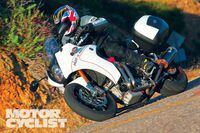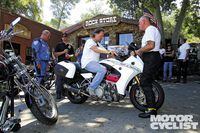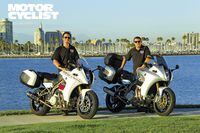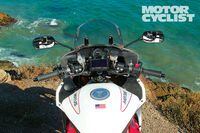Fate seemed to conspire against me. I'd flown to Los Angeles to test a pair of work-in-progress Motus sport-touring prototypes-the MST base model and the premium MST-R-only to arrive just in time for the ominous-sounding "Carmageddon." News reports were forecasting traffic jams of epic proportion, caused by the weekend-long closure of the San Diego Freeway through the Sepulveda Pass to demolish an outdated bridge. I needn't have worried: With most locals afraid to leave home, Carmageddon was a total non-event. I easily clocked more than 200 miles on everything from tight canyons to high-speed, Pacific Coast Highway sweepers to traffic-choked city streets-capped with a Sunday-morning visit to the fabled Rock Store on Mulholland Highway to gauge public reaction to the first four-cylinder streetbike built in America since World War II.
One thing is certain: The Motus draws attention, thanks to what is perhaps the most unique engine note in modern-day motorcycling. Powered by a 100-cubic-inch (1645cc), liquid-cooled, pushrod V4 built by Katech, a legendary Detroit auto-engineering firm, the so-called KMV4 sounds like half a NASCAR V8. One report from the twin Two Brothers Racing carbon-fiber exhaust cans brings bike nuts running. The KMV4 "Baby Block" is the literal and figurative heart of the MST, a clever mix of proven ideas and new technology that defines the attitude and character of this all-American machine. "What's more American than a pushrod V-motor?" asks Lee Conn, who, along with designer Brian Case, founded Motus. "A high-displacement pushrod engine could be hugely reliable, overbuilt and understressed, so it could last a long time." Katech, known for work on GM's many championship-winning endurance-racing cars, designed an exceedingly compact V4 that looks familiar to anyone who's ever studied a small-block Chevy.
A single, roller-bearing camshaft, chain-driven off the crank, sits deep in the valley between the cylinders, with steel pushrods operating two stainless-steel valves per cylinder. The engine bolts to a six-speed gearbox designed by Pratt & Miller-another tier-one GM partner in the Detroit area. The powertrain is positioned longitudinally in the frame, like a Honda ST1300, and tilted 15 degrees forward for knee clearance. Case designed the steel-trellis chassis, fabricated from 4130 chromoly tubes, and tied to a tubular swingarm that acts on a progressive-rate rocker-arm linkage. Reasonably aggressive steering geometry and a claimed 52/48 percent forward weight bias seem to emphasize sport _over _touring.
Climb aboard and you encounter a remarkably natural riding stance. Standover height is accessible at 31 inches, with a 32-inch option for taller riders. The seat, made for Motus by Sargent in Florida, gives good bum support, though the pad would benefit from additional softness, or perhaps a gel insert. Low-set footpegs and flat clip-ons deliver an upright, comfortable riding position that can be further tailored by adjusting the bars forward or back a full 5 inches, along with 15 degrees of angle adjustment. Footpeg position is fixed, but the toepieces on the shift lever and brake pedal can be adjusted. The windscreen is manually adjustable between four positions, raising a maximum of 3 inches. The middle settings create a cocoon of still air at 85 mph, with zero buffeting despite what looks to be a narrow bit of Plexiglas. Optional screens will be offered, too.
I was reminded during start-up that riding a still-green prototype demands one make allowances for a work still in progress. The Magneti Marelli ECU's cold-start mapping hasn't been optimized yet, so it required some finesse to coax the V4 to life. Blipping the throttle in neutral produces a slight torque reaction, as the lengthwise crank rocks the bike to the side, but this disappears the instant you select a gear. Twin counter-rotating balance shafts incorporated into the gearbox cancel this torque reaction completely out.
A smooth-running engine is a prerequisite for sport touring, and the Motus doesn't disappoint. With a 90-degree cylinder angle providing perfect primary balance, and those twin counterbalancers dulling secondary vibration, there's absolutely no buzzing below 7000 rpm, and only a slight tingle through the footpegs above that mark. With the rev limit set at 7800 rpm, this is hardly an issue. The KMV4's happy spot lies between 3000 and 6500 rpm, where you surf the serious waves of torque flowing from the half-a-V8. A little heat emanates from the engine at rest, though you don't notice this much at speed.
The KMV4 is the first production four-stroke motorcycle engine equipped with GDI (gasoline direct injection). A single injector sits _beneath _the butterfly of each Katech-made 40mm throttle body, with carbon rails squirting fuel below the valves and directly into the combustion chamber. Direct injection delivers a very finely atomized, cooler fuel mixture that is said to increase power, improve fuel economy and reduce emissions. Though a proven technology on the automotive side, the GDI system fitted to the Motus still needs some refinement. Fueling is fine under hard acceleration, but it's too abrupt off closed throttle, as I found many times midway through fast sweepers in the Santa Monica Mountains. Hopefully, this is just a question of fine-tuning the fuel-injection map.
The transmission is obviously still a pre-production component, as well. Shift action, though precise, is harsh, and the clutch is unacceptably stiff, quickly cramping your left hand in heavy traffic. The gear ratios are well chosen, however. The extremely torquey engine allows an ultra-long first gear, followed by three evenly spaced ratios, and then an overdrive fifth and sixth for supremely relaxed high-speed cruising-the engine only turns 4000 rpm in top gear at 75 mph. The gauge cluster incorporates a shift light, but we'd also like to see a gear indicator-the V4 is so torquey, and roll-on acceleration so stout, that it's difficult to keep track of which gear you're in!
Handling is remarkably good for a prototype, with neutral, intuitive steering manners and quick reflexes that make it feel more like a sportbike than the typical long-and-low, luggage-laden sport-tourer. Swooping down Stunt Road toward the Rock Store was sublime fun, though the footpegs quickly touched down in fast turns. The 190/55 rear tire seems an odd choice, as the footpegs ground before you can reach the edge of the tread. It's a bold visual statement, but a narrower, 180mm-wide rear tire would make the steering lighter. Top-line Ohlins suspension makes the most of the grippy Michelin Pilot Road 2 dual-compound tires, with standard settings that are perfectly calibrated for sport-touring. Handling is admirably sharp on technical roads and still smooth over broken surfaces like L.A.'s washboard concrete freeways. Brembo radial calipers grip 320mm Braking petal discs, though braking response is a bit too fierce to smoothly modulate; Case attributed this to racing-compound brake pads, which likely won't make it through to production.
There's some question whether there will be enough interested customers to make any sport-tourer viable, let alone one with a pushrod V4 built by an unknown American start-up. Conn and Case have done their homework, however, and say there are enough interested buyers for at least the relatively small annual volume of bikes they plan to build. The aim is to construct up to 250 units next year, building to 1000 annually in response to demand. After riding the MST-R prototype-a serious and credible attempt and creating a high-end, Made-in-the-USA sportbike-I reckon they're on the right track.
tech Spec
EVOLUTION
An all-new, American-made sport-tourer powered by a Chevy-inspired "Baby-Block" V4.
RIVALS
BMW K1300S, Honda VFR1200F, Kawasaki Concours14, Triumph Sprint ST, Yamaha FJR1300
TECH
VERDICT: 3.5 out of 5 stars.
**An exceptionally sporty sport-tourer with a strong, soulful, uniquely American character. **



















/cloudfront-us-east-1.images.arcpublishing.com/octane/QCZEPHQAMRHZPLHTDJBIJVWL3M.jpg)
/cloudfront-us-east-1.images.arcpublishing.com/octane/HXOUJXQWA5HBHGRO3EMJIGFMVI.jpg)

/cloudfront-us-east-1.images.arcpublishing.com/octane/3TIWWRV4JBBOLDVGRYECVVTA7Y.jpg)
/cloudfront-us-east-1.images.arcpublishing.com/octane/KIX5O23D5NAIBGFXBN3327DKZU.jpg)
/cloudfront-us-east-1.images.arcpublishing.com/octane/7GJYDUIPXRGMTMQKN6ONYOLBOU.jpg)
/cloudfront-us-east-1.images.arcpublishing.com/octane/MUQLOVLL2ZDGFH25ILABNBXKTI.jpg)
/cloudfront-us-east-1.images.arcpublishing.com/octane/TNOU5DNE2BC57MFPMGN2EIDXAM.jpg)
/cloudfront-us-east-1.images.arcpublishing.com/octane/GTCXACQGJ5HAPDTGWUQKDEH44E.jpg)
/cloudfront-us-east-1.images.arcpublishing.com/octane/S35YGSEMEZB4BLTDJTSZPF4GLA.jpg)
/cloudfront-us-east-1.images.arcpublishing.com/octane/5UOT6HPX2JFMRJAX6EH45AR4MQ.jpg)
/cloudfront-us-east-1.images.arcpublishing.com/octane/OKWOJWAKP5EP3OACCRRWPCIX2Q.jpg)
/cloudfront-us-east-1.images.arcpublishing.com/octane/2WF3SCE3NFBQXLDNJM7KMXA45E.jpg)
/cloudfront-us-east-1.images.arcpublishing.com/octane/G4MG6OUCJNBSHIS2MVVOTPX65E.jpg)
/cloudfront-us-east-1.images.arcpublishing.com/octane/IIGGWFOTOJGB7DB6DGBXCCMTDY.jpg)
/cloudfront-us-east-1.images.arcpublishing.com/octane/QSTCM6AVEZA5JJBUXNIQ3DSOF4.jpg)
/cloudfront-us-east-1.images.arcpublishing.com/octane/U4I7G625B5DMLF2DVIJDFZVV6M.jpg)
/cloudfront-us-east-1.images.arcpublishing.com/octane/B6XD6LS6IVCQPIU6HXDJSM3FHY.jpg)
/cloudfront-us-east-1.images.arcpublishing.com/octane/ICL63FEDDRDTTMINYICCEYGMDA.jpg)
/cloudfront-us-east-1.images.arcpublishing.com/octane/FCGZHQXRBZFLBAPC5SDIQLVF4I.jpg)
/cloudfront-us-east-1.images.arcpublishing.com/octane/WNOB6LDOIFFHJKPSVIWDYUGOPM.jpg)

/cloudfront-us-east-1.images.arcpublishing.com/octane/X33NU3E525ECRHXLNUJN2FTRKI.jpg)
/cloudfront-us-east-1.images.arcpublishing.com/octane/6KKT5NNL2JAVBOXMZYS5ZO76YA.jpg)